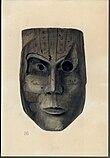References
- ↑ Hranicky, William J. (2010). North American Projectile Points (revised ed.). AuthorHouse. p. 393. ISBN 978-1-4520-2632-9.
- ↑ Ward, H. Trawick; Davis, R. P. Stephen (1999), Time before history: the archaeology of North Carolina, UNC Press Books, p. 31, ISBN 978-0-8078-4780-0
| | This article relating to archaeology in the United States is a stub. You can help Wikipedia by expanding it. |
